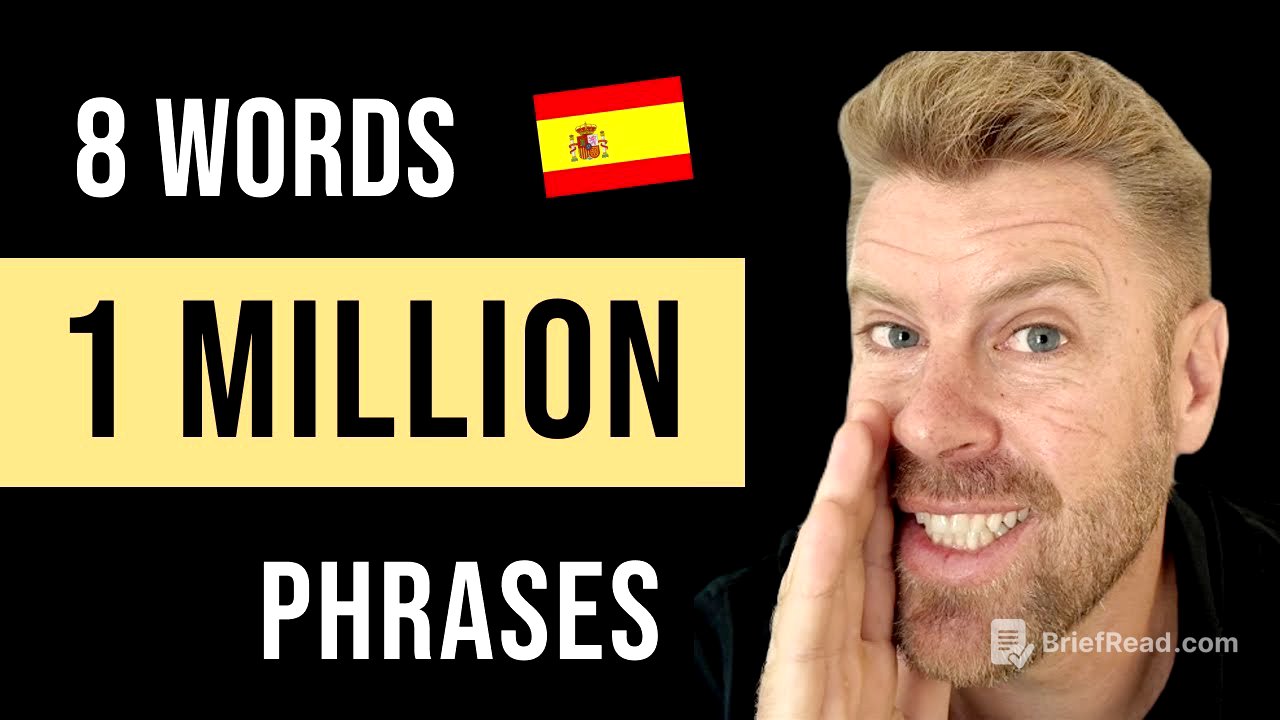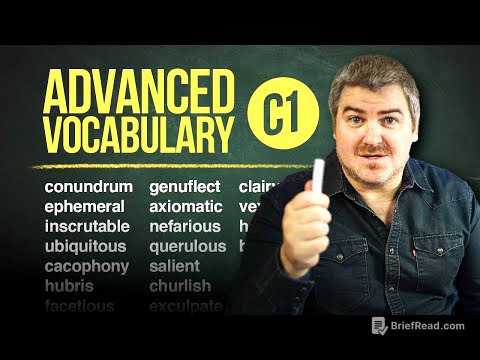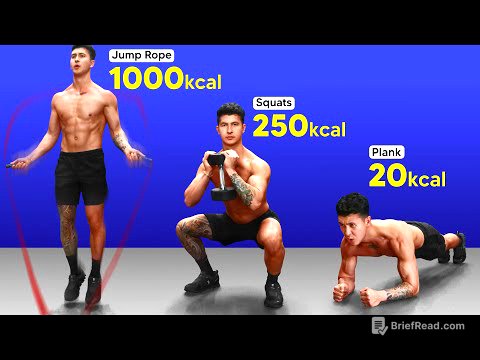TLDR;
This video introduces a method for learning Spanish efficiently by focusing on the most frequently used words. It challenges traditional language learning approaches that often prioritize a wide range of vocabulary and complex grammar, which are not essential for everyday conversations. The core idea is to master a small set of high-frequency words that form the foundation of most sentences.
- Focus on the top 300 words for basic conversation.
- Prioritize "I" and "you" forms of verbs initially.
- Use space repetition for effective memorization.
Intro: The Power of Eight Magical Words [0:00]
The presenter introduces the concept of eight "magical" words that can enable learners to express 87% of what they need to say in daily life in Spanish. He contrasts this approach with traditional language courses that often focus on a random assortment of words and complicated grammar, which can take years to master. The presenter, Rob, shares his frustration with traditional language learning methods and his quest to discover a more efficient way to learn a language, aiming to achieve conversational fluency in weeks rather than years.
The Layers Method: Building a Language Onion [0:52]
Rob explains his research-backed approach, the Layers Method, which prioritizes learning the most frequently used words first. He describes language as being structured like an onion, with a core of essential words needed for basic interactions, surrounded by layers of less frequently used but still important vocabulary. By focusing on the top 300 words across seven layers, learners can achieve basic conversational ability in Spanish.
Top Eight Words: The Foundation of Spanish [2:39]
The presenter highlights the importance of mastering the top eight most frequently used words in Spanish, which appear in almost every sentence. He demonstrates this by showing how these words are essential for constructing various sentences and points out that many common sentences provided by his audience include these words. Mastering these eight words is crucial for stringing together sentences in Spanish. The video will cover the first four words in this part, with the remaining four in a subsequent video.
The Challenge of Verb Conjugation in Spanish [5:52]
The presenter explains that unlike English, where verb forms remain consistent across different subjects (I, you, they), Spanish verb forms change depending on the subject. This makes learning Spanish more challenging, as learners must memorize different verb conjugations to use words correctly in sentences. The video will focus on the verb "querer" (to want) and how it changes based on the subject.
Word 1: "Querer" (To Want) [6:26]
The presenter begins with the verb "querer" (to want), illustrating how its form changes depending on the subject pronoun. For "I want," it becomes "yo quiero," with the verb ending changing to "o." For "you want," it becomes "tú quieres," with the verb ending changing to "es." He emphasizes that the "o" ending typically indicates "I," while the "es" ending indicates "you." He provides examples of how to use "quiero" and "quieres" in sentences, such as "Yo quiero un café, por favor" (I want a coffee, please) and "Tú quieres una cerveza" (You want a beer).
Word 2: "Ir" (To Go) [13:03]
The presenter identifies "ir" (to go) as the most powerful and frequently used word in Spanish, useful for various scenarios, including talking about the future. He explains that "ir" also changes form depending on the subject. "I go" is "yo voy," an exception to the "o" ending rule, and "you go" is "tú vas." He provides examples such as "Yo voy a la playa" (I go to the beach) and "Tú vas a la tienda" (You go to the shop). He also explains the contraction "al" (a + el) when "ir" is followed by a masculine noun.
Additional Vocabulary and Regional Variations [21:11]
The presenter provides additional vocabulary related to school, such as "colegio" (primary school) and "instituto" (high school), noting that these terms are commonly used in Spain and other Spanish-speaking countries. He also touches on regional variations in pronunciation, such as the "th" sound in Spain versus the "s" sound in Latin America for words with "c" and "z."
Focusing on "I" and "You" for Effective Learning [23:58]
The presenter emphasizes the importance of focusing on "I" and "you" forms in the initial stages of learning Spanish. He argues that in real-life conversations, learners primarily interact with one person at a time, making the "I" and "you" forms the most relevant. By mastering these forms, learners can start speaking and communicating more quickly, rather than getting overwhelmed by trying to learn all verb conjugations at once.
Word 3: "Tener" (To Have) [26:03]
The presenter introduces "tener" (to have), explaining that "I have" is "yo tengo" and "you have" is "tú tienes." He uses a spreadsheet to illustrate the patterns in verb endings, noting that verbs ending in "ar" often have "o" endings for "I" and "es" endings for "you." He provides examples such as "Yo tengo un coche" (I have a car) and "Tú tienes un niño" (You have a child).
Word 4: "Tener Que" (To Have To) [32:46]
The presenter introduces "tener que" (to have to), explaining that it's more commonly used than "necesitar" (to need) in Spanish. He explains that "tener que" implies a lack of something, indicating an obligation or necessity. He provides examples such as "Tengo que comprar un coche" (I have to buy a car) and "Tienes que tener niños" (You have to have children). He emphasizes that "tener que" is a top-eight word and is essential for sounding more natural in Spanish.
Combining Words and Constructing Longer Sentences [42:20]
The presenter demonstrates how to combine the four words learned (querer, ir, tener, tener que) to construct longer sentences. He provides examples such as "Quiero ir a la fiesta esta noche, pero tengo trabajo mañana, así que tengo que dormir" (I want to go to the party tonight, but I have work tomorrow, so I have to sleep). He emphasizes the importance of translating phrase by phrase and understanding the context to use the correct verb forms.
Emphasizing Contrast and Adding Nuance [46:43]
The presenter explains that while it's common to remove the subject pronouns "yo" and "tú" in Spanish, there are times when it's appropriate to include them for emphasis or to highlight a contrast. He provides an example of how adding "tú" can emphasize the difference between "I want to go, but you have to work."
Course Overview: The Layers Method [52:59]
The presenter introduces his full Spanish course, the Layers Method, designed to take learners from beginner to conversational fluency. He emphasizes that the course focuses on the top 300 words and essential grammar needed for everyday conversations. The course is structured around the layers of the onion, with each layer building upon the previous one. The course includes a unique flashcard app with spaced repetition to help learners memorize the most important words and phrases.









